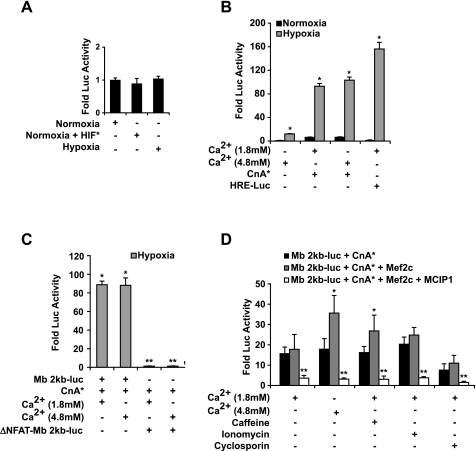Fig. 2.
Effect of hypoxia on myoglobin transcriptional activity in C2C12 myotubes. A: C2C12 myoblasts were transfected with the 2-kb myoglobin promoter (Mb 2kb) linked to a luciferase reporter plasmid (pGL3) in the presence or absence of activated calcineurin (CnA*) or activated hypoxia-inducible factor (HIF*). The effect of hypoxia and/or activated HIF on the 2-kb myoglobin promoter in 5-day differentiated C2C12 myotubes demonstrated that hypoxia alone did not promote myoglobin transcriptional activity in C2C12 myotubes compared with normoxic conditions. B: effect of hypoxia and activated calcineurin and/or calcium stimulation on the 2-kb myoglobin promoter in 5-day differentiated C2C12 myotubes. Exposure to increased supplemental calcium and/or cotransfection with activated calcineurin resulted in increased (10 ± 0.05-fold to 110 ± 10-fold; P < 0.005, n = 12) myoglobin transcriptional activity compared with normoxic conditions. *Significant difference between hypoxic and normoxic conditions (P < 0.005, n = 12). HRE, hypoxia response element. C: inhibition of nuclear factor of activated T cell (NFAT) binding to the myoglobin promoter abolished the effects of hypoxia and calcium stimulation on myoglobin transcriptional activity. C2C12 cells were transfected with either the 2-kb myoglobin promoter or a 2-kb myoglobin promoter with mutated NFAT binding sites (ΔNFAT-Mb 2kb-luc). Following transfection of either of these promoter constructs, the myotubes were exposed to supplemental or extracellular calcium and/or cotransfected with activated calcineurin. After 4 days of differentiation under hypoxic conditions, the wild-type myoglobin promoter had a significant increase in myoglobin transcriptional activity in the presence of the dual stimulation of hypoxia and enhanced calcium signaling (i.e., activated calcineurin). However, removing the calcium sensitivity of the myoglobin promoter by mutating its NFAT binding sites completely abolished the hypoxic response (n = 6 for each experiment). *Significant difference between hypoxic and normoxic conditions (P < 0.05). **Significant reduction from hypoxic stimulated Mb 2kb-luc (P < 0.05). D: inhibition of calcium signaling attenuated the hypoxic response of the myoglobin promoter. Calcium signaling was inhibited in C2C12 myotubes by either forced expression of modulatory calcineurin interacting protein 1 (MCIP1) or cyclosporin administration, which abolished the increase in myoglobin transcriptional activity observed with calcium stimulation and hypoxia. *Statistically different from Mb 2kb-luc + activated calcineurin (n = 6, P < 0.05). **Statistically different from Mb 2kb-luc + activated calcineurin and Mb 2kb-luc + activated calcineurin + myocyte enhancer factor-2 C (Mef2c) (n = 6, P < 0.05).

